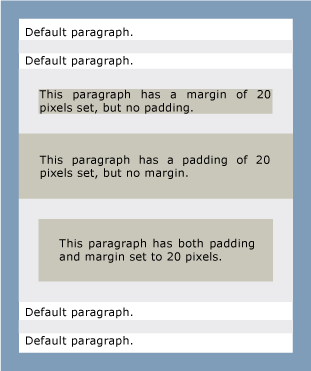ListItem.Padding Property
Definition
Important
Some information relates to prerelease product that may be substantially modified before it’s released. Microsoft makes no warranties, express or implied, with respect to the information provided here.
Gets or sets the padding thickness for the element.
public:
property System::Windows::Thickness Padding { System::Windows::Thickness get(); void set(System::Windows::Thickness value); };public System.Windows.Thickness Padding { get; set; }member this.Padding : System.Windows.Thickness with get, setPublic Property Padding As ThicknessProperty Value
A Thickness structure that specifies the amount of padding to apply, in device independent pixels. The default is a uniform thickness of zero (0.0).
Examples
The following example shows how to set the Padding attribute of a Block element (Paragraph).
<FlowDocument Background="LightSlateGray" ColumnWidth="2000">
<Section Background="DarkMagenta" Margin="0" Padding="0">
<Paragraph Background="White">
<Run>Default paragraph.</Run>
</Paragraph>
<Paragraph Background="White">
<Run>Default paragraph.</Run>
</Paragraph>
<Paragraph Background="LightBlue" Margin="50">
<Run>This paragraph has a magin of 50 pixels set, but no padding.</Run>
</Paragraph>
<Paragraph Background="LightCoral" Padding="50">
<Run>This paragraph has padding of 50 pixels set, but no margin.</Run>
</Paragraph>
<Paragraph Background="LightGreen" Margin="50" Padding="50">
<Run>This paragraph has both padding and margin set to 50 pixels.</Run>
</Paragraph>
<Paragraph Background="White">
<Run>Default paragraph.</Run>
</Paragraph>
<Paragraph Background="White">
<Run>Default paragraph.</Run>
</Paragraph>
</Section>
</FlowDocument>
The following figure shows how this example renders. Exaggerated thicknesses and colors are used for illustration.

The following example shows how to set the Padding property programmatically.
FlowDocument flowDoc = new FlowDocument();
Section sec = new Section();
flowDoc.Background = Brushes.LightSlateGray;
flowDoc.ColumnWidth = 2000;
sec.Background = Brushes.DarkMagenta;
sec.Padding = sec.Margin = new Thickness(0);
Paragraph defPar1 = new Paragraph(new Run("Default paragraph."));
Paragraph defPar2 = new Paragraph(new Run("Default paragraph."));
Paragraph defPar3 = new Paragraph(new Run("Default paragraph."));
Paragraph defPar4 = new Paragraph(new Run("Default paragraph."));
defPar1.Background = defPar2.Background = defPar3.Background = defPar4.Background = Brushes.White;
Paragraph marginPar = new Paragraph(new Run("This paragraph has a magin of 50 pixels set, but no padding."));
marginPar.Background = Brushes.LightBlue;
marginPar.Margin = new Thickness(50);
Paragraph paddingPar = new Paragraph(new Run("This paragraph has padding of 50 pixels set, but no margin."));
paddingPar.Background = Brushes.LightCoral;
paddingPar.Padding = new Thickness(50);
Paragraph marginPaddingPar = new Paragraph(new Run("This paragraph has both padding and margin set to 50 pixels."));
marginPaddingPar.Background = Brushes.LightGreen;
marginPaddingPar.Padding = marginPaddingPar.Margin = new Thickness(50);
sec.Blocks.Add(defPar1);
sec.Blocks.Add(defPar2);
sec.Blocks.Add(marginPar);
sec.Blocks.Add(paddingPar);
sec.Blocks.Add(marginPaddingPar);
sec.Blocks.Add(defPar3);
sec.Blocks.Add(defPar4);
flowDoc.Blocks.Add(sec);
Dim flowDoc As New FlowDocument()
Dim sec As New Section()
flowDoc.Background = Brushes.LightSlateGray
flowDoc.ColumnWidth = 2000
sec.Background = Brushes.DarkMagenta
sec.Margin = New Thickness(0)
sec.Padding = sec.Margin
Dim defPar1 As New Paragraph(New Run("Default paragraph."))
Dim defPar2 As New Paragraph(New Run("Default paragraph."))
Dim defPar3 As New Paragraph(New Run("Default paragraph."))
Dim defPar4 As New Paragraph(New Run("Default paragraph."))
defPar4.Background = Brushes.White
defPar3.Background = defPar4.Background
defPar2.Background = defPar3.Background
defPar1.Background = defPar2.Background
Dim marginPar As New Paragraph(New Run("This paragraph has a magin of 50 pixels set, but no padding."))
marginPar.Background = Brushes.LightBlue
marginPar.Margin = New Thickness(50)
Dim paddingPar As New Paragraph(New Run("This paragraph has padding of 50 pixels set, but no margin."))
paddingPar.Background = Brushes.LightCoral
paddingPar.Padding = New Thickness(50)
Dim marginPaddingPar As New Paragraph(New Run("This paragraph has both padding and margin set to 50 pixels."))
With marginPaddingPar
.Background = Brushes.LightGreen
.Margin = New Thickness(50)
.Padding = marginPaddingPar.Margin
End With
sec.Blocks.Add(defPar1)
sec.Blocks.Add(defPar2)
sec.Blocks.Add(marginPar)
sec.Blocks.Add(paddingPar)
sec.Blocks.Add(marginPaddingPar)
sec.Blocks.Add(defPar3)
sec.Blocks.Add(defPar4)
flowDoc.Blocks.Add(sec)
Remarks
Padding is buffer space that falls inside an element's content area, between the element's content and the inner edge of the element. Contrast with Margin, which is buffer space that falls outside an element's content area, between the edges of the element's content area and the edges of the parent element.
XAML Attribute Usage
<object Padding="uniformThickness"/>
- or -
<object Padding="independentThickness"/>
- or -
<object Padding="qualifiedUniformThickness"/>
- or -
<object Padding="qualifiedIndependentThickness"/>
XAML Values
uniformThickness
String representation of a single Double value to apply uniformly to all four thickness dimensions. For example, a value of "10" is equivalent to a value of "10,10,10,10". An unqualified value is measured in device independent pixels. Strings need not explicitly include decimal points.
independentThickness String representation of four ordered Double values corresponding to independent thickness dimensions for left, top, right, and bottom, in this order. The four values must be separated with commas; spaces are not allowed. For example, "5,10,15,20" results in 5 pixels of padding to the left of content, 10 pixels of padding above content, 15 pixels of padding to the right of content, and 20 pixels of padding below the content.
qualifiedUniformThickness
A value described by uniformThickness followed by one of the following unit specifiers: px, in.
px (default) is device-independent units (1/96th inch per unit)
in is inches; 1in==96px
For example, "1in" provides uniform padding of 1 inch in all directions.
qualifiedIndependentThickness
A value described by independentThickness, with each independent value followed by one of the following unit specifiers: px, in.
px (default) is device-independent units (1/96th inch per unit)
in is inches; 1in==96px
For example, "1.5in,0.8in,1.5in,0.8in". Unit specifiers may be mixed or omitted from one or more values.
Dependency Property Information
| Item | Value |
|---|---|
| Identifier field | PaddingProperty |
Metadata properties set to true |
AffectsMeasure |
